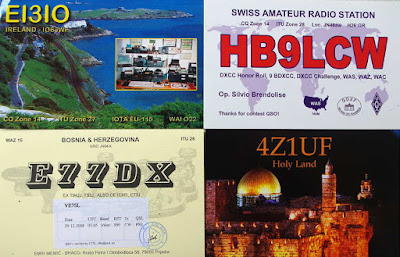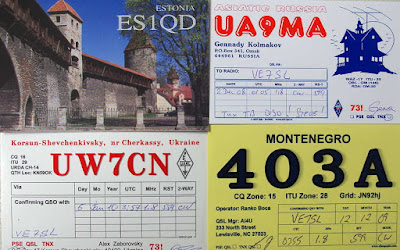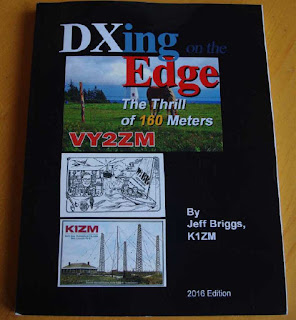Posts Tagged ‘160m’
 FT8 … Such A Tease
FT8 … Such A Tease
 |
| Looking towards EU over Georgia Strait, last winter |
With the continued tsunami of FT8 activity on the HF bands, I decided to have a look at what was happening in the FT8 segment of 160m.
On Saturday afternoon, about ninety minutes before my local sunset here in south west British Columbia, I set my receiver and 160m half-sloper to work, along with WSJT-X, on 1840kHz USB mode.
Although still in broad daylight, the waterfall was immediately flooded with signals! As I started to pay closer attention, I realized that many of the signals were from Europe! Many were audible while the rest were fast-approaching that level, being stronger than -20db. I let the receiver run for another few hours and took a screen capture of my PSK Reporter screen, illustrating what had been decoded over that time span:
 |
| courtesy: https://www.pskreporter.info/pskmap.html |
Checking other NW or VE7 monitors during the same time span showed no EU decodes at all, which I found surprising ... perhaps I missed someone. My location here on the eastern shoreline of Mayne Island looks towards EU and many other directions directly over a large body of saltwater ocean, Georgia Strait. The photo above was taken last winter, through the living room window. It is also very quiet, electrically, with little or no noise most of the time.
It appears that the lack of man-made noise combined with the theoretical 6db saltwater horizon gain (being realized), is enough to allow these signals to be heard. Signals continued to be decoded as darkness approached but at around 1800 local time, began to drop off ... evidently this appears to be a sunset enhancement, similar to what I often see to the east coast on the 630m band.
Now here’s where it gets even more interesting, as my decodes for the ninety minutes before and after local sunrise indicated a similar pattern!
The most probable path for these signals, around sunrise, would be via the long path in darkness. Although there is no saltwater directly behind me, it seems that the 'quietness' may be enough to do the job. Here’s the slightly post-sunrise screen cap from PSK Reporter:
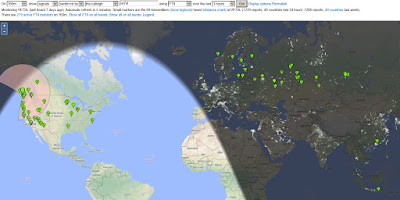 |
| courtesy: https://www.pskreporter.info/pskmap.html |
FT8 is surely a tempting seductress. So far I have resisted the fast-growing urge to spark-up in this mode on 160m ... but I may be growing weaker. This all looks so very interesting.
 Will The Sun Get Too Quiet For Topband DX?
Will The Sun Get Too Quiet For Topband DX?

Those of us that like to hunt European DX on 160m from the west coast know that the best time for this is during the 'solar low' years, those quiet periods between the end of one solar cycle and the beginning of the next.
From the west coast, openings to Europe on 160m are not something that happens with much regularity and, unlike the more frequent paths to Europe enjoyed from the east coast, are almost exclusively limited to this quieter part of the solar cycle. The weakening of the Sun's magnetic field at these times allows for less prop-killing D and E-layer signal absorption, particularly through the northern auroral zone path required from the west coast.
In his October, 2016, posting to the Topband reflector, propagation guru Carl Luetzelschwab, (K9LA), suggested that the coming years of solar lows may actually be too low and that because of the likely unprecedented low levels not seen in our lifetimes, the planet could receive higher cosmic-ray bombardment than normally associated with these periods.
"Since galactic cosmic rays are mostly *very energetic* protons, they can get down to low atmospheric altitudes, causing collisional ionization in the D region (and lower E region). A cursory estimate using cosmic ray ionization rates confirms more ionization in the lower atmosphere. 160m is not very tolerant of more absorption, so we may see an adverse effect of the weakened solar magnetic field."
K9LA's Topband comments seems to have its roots in his May, 2015 article, "What's Going On With-160 Meters?", where he compares the solar minimum period between Cycles 22 and 23 to the minimum years between Cycles 23 and 24. Carl noted that the best 160m propagation period that he had seen in his lifetime was during the years between Cycle 22 and 23 and pondered why, during the even deeper prolonged low between Cycles 23 and 24, was it not producing the same levels of great propagation observed 11 years earlier. One possibility he puts forward was that ...
" ... it involves galactic cosmic rays (GCRs). At solar maximum, the Sun is more active, causing more geomagnetic field activity that is believed to be detrimental to 160-Meter propagation. Coupled with the Sun being more active is the fact that the Sun's magnetic field is stronger, which shields the Earth from galactic cosmic rays. Going the other way, when we're at solar minimum, the Sun's magnetic field is weakest, letting in more cosmic rays."
His graph shows the yearly trend of only the low Ap index days (geomagnetically quiet) versus smoothed sunspot numbers for several recent cycles. The blue line plots the trend of low Ap index values with the black line showing the smoothed values; the red line indicates the smoothed sunspot number (solar activity levels).
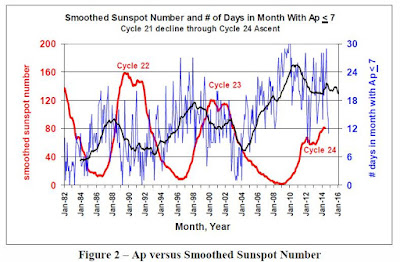 |
| source: http://k9la.us/May15_What_s_Going_On_with_160-Meters.pdf |
Carl's earlier observations indicating that the best 160m propagation he had ever observed was during the low period between Cycle 22 and 23 and not during the much quieter low period between Cycle 23 and 24 are very much different than my own ... perhaps because of our different locations.
From the west coast, the most challenging topband path is over the pole to Europe. This only occurs during 'best propagation' periods as this path will only open during prolonged periods of very low geomagnetic activity. Unlike Carl's path to Europe, west coast signals need to traverse the signal-killing auroral zone.
During the first low period, I did experience several openings to Europe but nothing compared to what they were during the second low period, between Cycles 23 and 24, the one Carl did not experience propagation as good as the previous low. For several winters in a row, during the 23-24 low, I often found night after night of amazing propagation to Europe, the quality of which I had never heard before. Interestingly, on almost all of these nights, there were no other signals on the band but Europeans and nearby Washington or Oregon state W7s ... no signals at all from the rest of North America. At times it mimicked the sound of 20m CW to Europe, with signals often reaching S9 on my FT-1000 S-meter. I even worked one SM station on CW while running just 10W output!
With this long intense low, cosmic ray bombardment should have been at an all time high ... maybe it was, but it didn't seem to be bothering the west coast path to Europe, via the seemingly dormant auroral zone.
I was prompted to address this topic after reading a recent report on the GeoSpace website, siting a new study led by Nathan Schwadron, professor of physics at the University of New Hampshire’s Space Science Center. In the study, recently published in the journal Space Weather, a publication of the American Geophysical Union, the researchers found that large fluxes in Galactic Cosmic Rays (GCR) are rising faster and are on a path to exceed any other recorded time in the space age.
The author's study predicted a 20% increase in radiation bombardment but their newest research shows current conditions exceed their predictions by about 10 percent, showing the radiation environment is worsening even more than expected.
With cosmic ray levels now predicted to increase by a whopping 30%, Carl and the rest of us may soon get some clarity on his original postulation that "maybe a solar minimum can be too deep for 160 meters."
With the next few cycles expected to be even poorer than the present one, the large increase in radiation levels from space may have profound impacts on more than just propagation ... satellites and, with a new appetite to return human activity to the moon, astronauts could be exposed to much higher radiation levels than ever before.
The next few years of (ultra?) solar-quiet should be very interesting!
 The JK BevFlex-4 Antenna
The JK BevFlex-4 Antenna

This past week, comments regarding an interesting new low-noise directionally-switched receive antenna popped-up on both the Topband reflector and the IRCA (BCB DXers) reflector.
The new JK BevFlex-4 is reported to work very well without requiring a lot of real estate for deployment. The antenna was designed by Geoff Mendenhall, W8GNM, and Ned Mountain, WC4X.
There are several things that make this package a little different. The antenna can be configured in four basic forms: CLASSIC BEVERAGE, BEVERAGE ON GROUND (BOG) / BEVERAGE IN SOD (BIS), INVERTED EWE, or as a FLAG. What is quite different however is its flexible feedpoint allowing the antenna to be fed at any point along its length when used in the BOG or BEVERAGE configuration. The antenna is completely passive and requires no preamplification although, in some configurations, it is suggested for use above 7MHz.
Full details can be found at the JK Antennas website, as well as the manual and a FAQ page.
The FAQ sheet indicates that it will perform from LW through to 10m but the most dramatic improvement in reception from users has been noted on the lower bands. It sounds like it might make an interesting antenna for NDB DXing as well.
In the BOG form, the antenna can lay right on the ground or be buried (BIS) just below the surface using RG-6 for the actual antenna element. Other configurations allow much smaller, stealth-sized wire to be employed.
An interesting YouTube video of the antenna in action as well as an in-depth description may be viewed here:
Here is one comment from an east coast topbander:
I also bought one this year....deployed it as an EWE, as that’s all the room
I have, small lot in a subdivision.....in order to work them you need to
hear them, and once I put that up, I could hear !!! first put up as EU/VK-ZL
and worked several in the DX contest, but when the african dxpedetions were on, moved it to due east/west., and worked all of them, S01, etc.....front to back is remarkable on 160, it works ok on 80, (mine was 10ft high and 38 ft long) but really rocks on 160 !!!!, and really cuts down the line noise/static I normally hear on my transmit Inv L.
Perhaps this may be your answer for a small effective receive antenna for LW and above but even if not, their website description makes for interesting reading.
 The JK BevFlex-4 Antenna
The JK BevFlex-4 Antenna

This past week, comments regarding an interesting new low-noise directionally-switched receive antenna popped-up on both the Topband reflector and the IRCA (BCB DXers) reflector.
The new JK BevFlex-4 is reported to work very well without requiring a lot of real estate for deployment. The antenna was designed by Geoff Mendenhall, W8GNM, and Ned Mountain, WC4X.
There are several things that make this package a little different. The antenna can be configured in four basic forms: CLASSIC BEVERAGE, BEVERAGE ON GROUND (BOG) / BEVERAGE IN SOD (BIS), INVERTED EWE, or as a FLAG. What is quite different however is its flexible feedpoint allowing the antenna to be fed at any point along its length when used in the BOG or BEVERAGE configuration. The antenna is completely passive and requires no preamplification although, in some configurations, it is suggested for use above 7MHz.
Full details can be found at the JK Antennas website, as well as the manual and a FAQ page.
The FAQ sheet indicates that it will perform from LW through to 10m but the most dramatic improvement in reception from users has been noted on the lower bands. It sounds like it might make an interesting antenna for NDB DXing as well.
In the BOG form, the antenna can lay right on the ground or be buried (BIS) just below the surface using RG-6 for the actual antenna element. Other configurations allow much smaller, stealth-sized wire to be employed.
An interesting YouTube video of the antenna in action as well as an in-depth description may be viewed here:
Here is one comment from an east coast topbander:
I also bought one this year....deployed it as an EWE, as that’s all the room
I have, small lot in a subdivision.....in order to work them you need to
hear them, and once I put that up, I could hear !!! first put up as EU/VK-ZL
and worked several in the DX contest, but when the african dxpedetions were on, moved it to due east/west., and worked all of them, S01, etc.....front to back is remarkable on 160, it works ok on 80, (mine was 10ft high and 38 ft long) but really rocks on 160 !!!!, and really cuts down the line noise/static I normally hear on my transmit Inv L.
Perhaps this may be your answer for a small effective receive antenna for LW and above but even if not, their website description makes for interesting reading.
 Topband Trifecta
Topband Trifecta
It was a week of 'threes' when it comes to the 'gentleman's band'. The first was last weekend's CQ 160m CW Contest ... exciting as always, with propagation from VE7 land favoring the southeast. At times, signals from the Caribbean were exceptionally strong while it was a struggle on both nights to work eastern W1's. As usual, I entered in the low power division with a power limit of 150 watts, spending 8 hours in total and finishing with 249 contacts in 51 sections / 8 countries. Other than the odd State QSO Party, the 160m contests are about the only ones I enter these days.
The mail brought my next two Topband delights. The first being a copy of Jeff Brigg's (K1ZM / VY2ZM) spanking new "DXing on the Edge - The Thrill of 160 Meters". This is the second edition of Jeff's original classic which was published twenty years ago in 1997.
The new second edition carries all of the original content (except for the CD) along with four new added chapters. Although the original material is dated, it is still just as valuable and informative as it was when first published. Highlights of the book include chapters on:
- Propagation
- The Stew Perry Era (1930-1982)
- 160m DX Chronology 1930 - Present (8 Chapters)
- Notable Achievements
- Simple and Effective DX Transmitting Antennas
- Simple and Effective Receiving Antennas
- Tips From DXers
- Photographic Potpourri
- Off-The-Shelf Transmitting Antenna Solutions (new)
- Modern RX Solutions For Small Properties (new)
- Cycle 24 & A View Forward (new)
- 160m Achievement Levels As Of 2016 (new)
If you have any serious interest in DXing on 160m, you will find much inspiration in Jeff's book. The descriptions of many stations, from the simple to the extreme, highlight the fact that almost anyone can achieve DX success on the 'Topband' with a little perseverance and some thoughtful station design.
When it comes to Topband DXing, things have changed a lot since 1997 ... as Jeff indicates in the new section, his main reason for releasing a second updated version:
" ... was to publicly review the technical advances that are now available to the modern 160M DX'er. In this way, everyone - old timers and newcomers alike - would have the time to "get ready" for some great years that will be coming soon on Topband. So get going ... gear up ... start making plans now to be part of the action. It is probably going to be a wild ride ahead and a lot of DX'citement for those who are up to the challenge!"
If the coming solar low years are anything like the last previous low, we are indeed in for some fun times!
Jeff's book can be purchased through numerous outlets including Amazon and Chapters, often with free-delivery.
The third Topband event, again via the mail, was the arrival a new 160m QSL.
The sunrise 160m CW contact with H4ØGC, Temotu, was confirmed country #159 for me on Topband, with most of these being worked from here on Mayne Island using a half-sloper and an aging 500 watt amplifier with a pair of original 572Bs.
If you've not been on 160m and are keen on new operating challenges, Topband may be the place to begin ... along with a copy of Jeff's inspirational 'Topband handbook'.
 Topband Trifecta
Topband Trifecta
It was a week of 'threes' when it comes to the 'gentleman's band'. The first was last weekend's CQ 160m CW Contest ... exciting as always, with propagation from VE7 land favoring the southeast. At times, signals from the Caribbean were exceptionally strong while it was a struggle on both nights to work eastern W1's. As usual, I entered in the low power division with a power limit of 150 watts, spending 8 hours in total and finishing with 249 contacts in 51 sections / 8 countries. Other than the odd State QSO Party, the 160m contests are about the only ones I enter these days.
The mail brought my next two Topband delights. The first being a copy of Jeff Brigg's (K1ZM / VY2ZM) spanking new "DXing on the Edge - The Thrill of 160 Meters". This is the second edition of Jeff's original classic which was published twenty years ago in 1997.
The new second edition carries all of the original content (except for the CD) along with four new added chapters. Although the original material is dated, it is still just as valuable and informative as it was when first published. Highlights of the book include chapters on:
- Propagation
- The Stew Perry Era (1930-1982)
- 160m DX Chronology 1930 - Present (8 Chapters)
- Notable Achievements
- Simple and Effective DX Transmitting Antennas
- Simple and Effective Receiving Antennas
- Tips From DXers
- Photographic Potpourri
- Off-The-Shelf Transmitting Antenna Solutions (new)
- Modern RX Solutions For Small Properties (new)
- Cycle 24 & A View Forward (new)
- 160m Achievement Levels As Of 2016 (new)
If you have any serious interest in DXing on 160m, you will find much inspiration in Jeff's book. The descriptions of many stations, from the simple to the extreme, highlight the fact that almost anyone can achieve DX success on the 'Topband' with a little perseverance and some thoughtful station design.
When it comes to Topband DXing, things have changed a lot since 1997 ... as Jeff indicates in the new section, his main reason for releasing a second updated version:
" ... was to publicly review the technical advances that are now available to the modern 160M DX'er. In this way, everyone - old timers and newcomers alike - would have the time to "get ready" for some great years that will be coming soon on Topband. So get going ... gear up ... start making plans now to be part of the action. It is probably going to be a wild ride ahead and a lot of DX'citement for those who are up to the challenge!"
If the coming solar low years are anything like the last previous low, we are indeed in for some fun times!
Jeff's book can be purchased through numerous outlets including Amazon and Chapters, often with free-delivery.
The third Topband event, again via the mail, was the arrival a new 160m QSL.
The sunrise 160m CW contact with H4ØGC, Temotu, was confirmed country #159 for me on Topband, with most of these being worked from here on Mayne Island using a half-sloper and an aging 500 watt amplifier with a pair of original 572Bs.
If you've not been on 160m and are keen on new operating challenges, Topband may be the place to begin ... along with a copy of Jeff's inspirational 'Topband handbook'.
 My Favorite Contest
My Favorite Contest

A few blogs back, I briefly touched upon my favorite contest of the year ... the 160m Stew Perry Contest, or more affectionately noted as the 'Stew' or 'SP'.
The contest is named in honor of W1BB, one of the earliest and most dedicated proponents of 160m in its earlier days, as well as being the first amateur to earn 160m DXCC #1, in 1976.
 |
| courtesy: http://www.k1zm.com/w1bb |
These bulletins were chalk-full of DX reports, station information, and antenna-building hints. It was hard not to get excited about the Topband after reading one of Stew's bulletins!
This was largely back in the day when very few commercial transmitters had a 160m position on the bandswitch. If it did, it was most likely a hernia-making DX-100 or a similar E.F. Johnson biggy ... seems most 160m ops were he-men back in the early days.
 |
| Heathkit DX-100 |
The 'Stew' is just a short 24 hour affair but often packs the CW band from end to end with a ton of activity, including lots of DX. It seems that most 160m diehards will jump at any opportunity to get on their favorite band, especially when conditions are as good as they have been of late.
The 'SP' is somewhat unique in that its system of scoring is probably the fairest of any contest around. The number of points earned for any QSO is determined by the distance between the two stations, with your computer contesting software dutifully making the needed calculations automatically from the exchange of Grid Square information, rather than the ubiquitous '599'.
Such a system gives stations in the western half of North America a chance to compete, on equal grounds, with the much higher activity levels found back east. With most contests awarding fixed points per QSO, it is much easier for eastern stations to rack-up big scores by working the multitude of other easterners ... this is just not possible out west where activity levels, and population densities, are so much smaller.
Contest PR-man ... Lew, W7EW, on behalf of the Boring (Oregon) Amateur Radio Club sponsorship, has sent a heads-up via the Topband reflector, which is reproduced below in case you wish to learn more.
Greetings Radio Ruffians with a TopBand Bent,
The anticipation is palpable as time draws near for the
start of the 21st Running of The Stew Perry TopBand DX
Challenge sponsored by the multitude of Amateurs who
make up The Boring Amateur Radio Club. The contest is Dec
17/18. That is this weekend coming up, for those of you
that need reminders like to remember an anniversary, put
gas in the vehicle or to breathe.
The rules for this contest are different. Please navigate to
http://www.kkn.net/stew/ and see how they are different.
Another unique aspect of The Stew is that The Boring
Amateur Radio Club does not specify categories to win
handsome plaques. You, the combatants do that. Yes,
anyone who thinks up a stellar category and remits $60 or
$63 to us will join the radio stalwarts listed below who are
stoking the fires of competition.
KL7RA Top # of QSOs by a S/O
N0TT Top Score, S/O, <21Y/O, > 200 QSOs
K7CA Longest DX, S/O, Low Power from Zone 3
K7CA Top Score S/O CQ Zone 19,24,25,27,28 or China
KH6LC VK/ZL Challenge- Top S/O VK-ZL
AA6VB Top Score Big City >50K, Little Pistol <100W
AA6VB Top Score Base Loaded Vertical < 60' tall
N6TQ/A25TQ California Dreaming- Top # of QSOs with Cal
VK0EK Stations by a non-California station
Rochester DX Assoc Top Score,S/O, L-P, Outside N. America
UX1UA Top # NA + SA QSOs by Zone 16 station
K7FL Top Score 100% Search and Pounce
K9JWV/WC7S Top QRP Score,West of Mississippi,wire antennas
Dr. Beldar-L1AR Top Score,S/O, Temporary Antenna erected > Dec.3
(All parts of temporary antenna including radials must be
installed after Dec. 3, 2016. This antenna must be the only antenna
for TopBand at the station and may be left erected because as we
all know "temporary" means "until I die")
KR2Q Golden Log Award
K2PO Top Score, S/O, Low Power, Zone 3
N6TR Top Score,S/O, Hi Power from CN Grid Field
W2GD Team Top # QSOs, NA/SA by EU Station
K6ND K6SE Memorial- Top Score, S/O, World
WA6CDR N5IA Memorial- Top # of Grids Worked
WA8WZG Top Score, S/O, by a 6 character call (Example- KA2BFD
or WD6XYZ)
W7RH Top Score, Low Power Asia
K1EP Top Score (>100QSOs) by YL or XYL
VE9AA Yr Trees Ants? If you have your TX wires in the trees or even
attached to 1 tree and your adjudicated score is closest one to
tree tree tree tree (3,333), then you win this plaque
VK6VZ VK6HD Memorial- Top Score by N. hemisphere station working S.
hemisphere stations.
Winner gets a new, fresh Flying Doctors of VK baseball hat
This list grows but will become even longer after you dream up a
contesting category. Just email me with the particulars so we may flesh it
out as some prior plaque proposals were too obtuse, couldn't be performed
by any one of our species or just a tad obscene.
There will be one or two more postings of the categories and sponsors
right up until and through the start of The Stew so don't delay! Also those
who haven't sent off their check or PayPals for their plaque sponsorship yet should not delay either.
Also follow Stalwart's VK6VZ's example and go fire up your system
tonight so you won't be modally morose when the only thing that happens
when you call CQ is that you open and close the neighbor's garage door
with a distinctive cadence.
73 and I remain,
Lew w7ew
The Boring Amateur Radio Club Committee on Participation
[email protected]
If you have a few hours of free time this Saturday night, why not give the 'Stew' a look, especially if you've never operated on the Topband. If you can load-up that old longwire on 160, I'll guarantee you'll have fun as well as be surprised at what you can work ... hopefully I'll see many of you this weekend in the best contest of the year!
